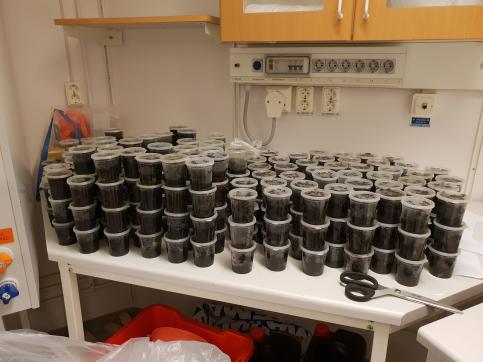Material & Methods
Locations

Explanatory variables

This study focused on measurements of each individual cavity (cavity length and cavity height) instead of dividing each tree into a category. Hence, a continuous scale of cavity sizes was used instead of stages as in a previous study on hollow oaks. Cavity size were calculated by multiplying cavity length and width to get an estimate of the entrance area. Other parameters measured for each oak was canopy cover, forest regrowth, trunk circumference, cavity direction, cavity level from ground. In addition to this, coordinates for all trees were taken to enable maps to be made in GIS. Trunk circumference and in what distance from ground the cavity were located were measured using a measuring tape. Forest regrowth was measured by looking around the oak in all four directions around the oaks and note how many that were obscured by small trees, large bushes etc. which resulted in a categorical variable with 1, 2, 3 and 4 depending on the number of regrowth covered directions. Canopy cover was calculated using a fisheye lens taking hemispherical photographs straight up from beneath cavities. These photos were analyzed using the CIMES FISHEYE method.
Beetle sampling
Collecting beetles was done using window-traps (approximately 30x60 cm) that were placed in a 90° angle as close to the cavities as possible on each oak. Window trapping is the best method to use if the aim is to find as many species of saproxylic beetles from the old oaks as possible. These traps were filled with water and propylene glycol (antifreeze , 50:50 ) which kill the beetles and preserve them between days of sampling. A bad tasting detergent and soap were added to make sure no animals, such as cows and horses, did not drink from them and to reduce the surface tension. Traps were set up in the beginning May (10-13) and emptied every third week until taken down during the final collecting in the end of August (22-23).
The beetles were sorted at a lab and later identified. Some beetles were identified by Nicklas Jansson at Linköping University while other were sent to Gunnar Sjödin, a beetle expert that is specialized in the Staphylinidae family for identification.
Saproxylic beetle divisions
All beetles were divided into different guilds depending on their preferred habitat or food source.
ROT - rotten wood in any part of the trunks except in hollows
HOLLOW - rotten wood and wood mould in trunk hollows
FUNGI - mold on wood surface or fruiting bodies of saproxylic fungi
DRY - dead dry wood in trunks
BRANCH - branches of old oaks
NEST - animal nests in tree hollows or other saproxylic habitats
BARK - in/under bark or at sap runs
LOG - rotten wood on laying logs
GEN - generalists on all or several saproxylic habitats

Responsible for this page:
Director of undergraduate studies Biology
Last updated:
05/06/19
